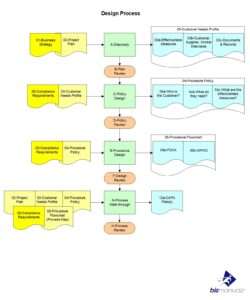What is the Difference Between Protocol and Procedure?

As professionals working in various industries, we use protocols and procedures in our daily routines. Regardless of the nature of our work, we all need to understand the difference between these two terms. While they might seem similar, they are distinct concepts that serve different purposes and have different applications. What is the difference between protocol and procedure?
Defining Protocol and 
To understand the difference between protocol and procedure, we first have to define both protocol and procedure. Let us look at what is a protocol and what is a procedure.
What is Protocol?
Protocol is a formal set of rules, guidelines, or conventions that define how to behave in specific situations or events. These rules are meant to ensure that people behave appropriately in formal or diplomatic situations. Protocols are mostly used in diplomatic and formal events, but they can also be applied in other settings such as business meetings or academic conferences.
For example, when attending a formal dinner, there is a protocol that dictates how to behave at the table. This includes using the correct cutlery, not speaking with your mouth full, and waiting for the host to start eating before you begin. Similarly, when meeting with a foreign dignitary, there are protocols that dictate how to greet them, how to address them, and how to conduct yourself during the meeting.
Protocols are important because they help to establish order and respect in formal situations. They also help to prevent misunderstandings and miscommunications by providing a clear set of guidelines for behavior.
What is Procedure?
Procedure refers to a set of steps or actions required to complete a specific task or process. Procedures are generally more flexible and can be customized based on the nature of the process, the organizational context, and the resources available.
For example, in a healthcare setting, there are procedures for administering medication, taking vital signs, and performing medical procedures. These procedures are designed to ensure that patients receive the correct treatment in a safe and efficient manner.
In the manufacturing industry, there are procedures for assembling products, testing them for quality control, and packaging them for shipment. These procedures are designed to ensure that products are produced to a high standard and meet customer expectations.
Procedures are important because they help to ensure consistency and quality in processes. They also help to identify potential problems and provide a framework for addressing them.
Key Differences Between Protocol and Procedure
Purpose and Goals
The main difference between protocol and procedure is their purpose and goals. Protocol aims to define a standard of behavior that is expected in different official or formal events. It seeks to ensure that people follow specific customs, traditions, or practices that are considered appropriate in such contexts.
For example, in diplomatic events, protocols dictate that heads of state should greet each other with a specific handshake, bow, or curtsy, depending on their culture and gender. These protocols help to establish a respectful and cordial atmosphere, which is essential for building trust and fostering cooperation.
On the other hand, procedures aim to provide a framework that guides people on how to perform certain tasks efficiently and effectively. The goal is to ensure that everyone follows the same steps to achieve the desired outcome, regardless of their background or experience.
For instance, in healthcare, procedures dictate how to diagnose, treat, and monitor patients with different conditions or illnesses. These procedures help to ensure that patients receive consistent and high-quality care, which is essential for improving health outcomes and reducing medical errors.
Flexibility and Rigidity
Another significant difference between protocol and procedure is their flexibility. Protocols are usually strict and leave little room for improvisation or personalization. For instance, formal protocols such as those used in diplomatic events require people to adhere to specific clothing, language, or gestures. Failure to observe these rules might result in diplomatic incidents or misunderstandings.
Procedures, however, are more flexible and allow for adaptations based on the context or the available resources. For instance, healthcare procedures can be adjusted to accommodate patients with different conditions or symptoms.
Doctors and nurses can modify the dosage, frequency, or duration of treatments based on the patient’s response or feedback. This flexibility helps to ensure that patients receive personalized and responsive care, which is essential for improving their health outcomes and satisfaction.
Scope and Application
The third difference between protocol and procedure is their scope and application. Protocols are mostly used in official or formal events such as diplomatic meetings, state visits, or royal ceremonies. They are designed to ensure that everyone involved in such events behaves in a specific way to maintain decorum and respect.
Procedures, on the other hand, can be applied in different contexts and industries, from healthcare and manufacturing to scientific research and emergency response. They are meant to provide a framework that guides people on how to perform tasks efficiently and effectively.
For example, in manufacturing, procedures dictate how to assemble, test, and package products to ensure quality and safety. These procedures help to ensure that products meet the required standards and specifications, which is essential for building customer trust and loyalty.
Examples of Protocols and Procedures
Protocols in Diplomacy and International Relations
In diplomacy and international relations, protocols are formal sets of rules that define how to behave during official events or meetings. For instance, protocol dictates how to greet dignitaries or high-ranking officials, how to address them, and what gifts to offer. Failure to observe these protocols can result in diplomatic incidents or misunderstandings.
Furthermore, protocols in diplomacy and international relations also extend to the rules of engagement between different countries and governments. These protocols dictate how countries interact with one another, how disputes are resolved, and how agreements are made.
They also define the rules of war and how to conduct negotiations between countries. Without these protocols, international relations would be chaotic and unpredictable.
Procedures in Healthcare and Emergency Response
In healthcare and emergency response, procedures are a set of steps or actions that healthcare professionals and emergency responders follow to diagnose, treat, or manage patients. For instance, emergency response procedures dictate how to respond to different types of emergencies, from natural disasters to mass casualties. Healthcare procedures, on the other hand, guide healthcare professionals on how to diagnose, treat, and manage different medical conditions.
Moreover, procedures in healthcare and emergency response are critical to ensuring patient safety and improving patient outcomes. These procedures are constantly evolving and being updated with new research and technology to provide the best possible care to patients. In addition, procedures also help to standardize care across different healthcare settings, ensuring that patients receive the same level of care regardless of where they are treated.
Overall, protocols and procedures play a crucial role in maintaining order and ensuring safety in various fields, from diplomacy to healthcare. By following these formal sets of rules, individuals can navigate complex situations with ease and confidence, ultimately leading to better outcomes for everyone involved.
The Importance of Protocols and Procedures in Various Industries
Protocols and procedures are essential in various industries to ensure that operations are conducted in a systematic and replicable manner. They help organizations to be more efficient, effective, and consistent in their operations. What about the importance of protocols and procedures in different industries?
Business and Management
Protocols and procedures are crucial in business and management because they help organizations to achieve their goals and objectives. By using protocols to standardize their hiring, training, and performance evaluation processes, organizations can ensure that all employees are treated fairly and equitably. This can help to boost employee morale and productivity.
Procedures can also help organizations to streamline their operations, identify bottlenecks, and reduce costs. For instance, manufacturing procedures can help organizations to optimize their production processes, minimize waste, and increase their output. This can help organizations to remain competitive in the market and maximize their profits.
Science and Research
Protocols and procedures are critical in science and research because they ensure that experiments are conducted in a systematic and replicable manner. This is essential to ensure that the results obtained are valid and reliable. Protocols are used to standardize different aspects of research, such as data collection, sample preparation, and analysis. By doing so, researchers can compare their results with other studies and validate their findings.
Procedures can also help researchers to optimize their research workflows, avoid errors, and minimize bias. For instance, procedures can be used to ensure that experiments are conducted under controlled conditions, and the results obtained are not affected by external factors. This can help to improve the quality of research and enhance the credibility of scientific findings.
Law and Government
Protocols and procedures are fundamental in law and government because they help to ensure that justice is served, and the rule of law is upheld. Protocols are used to guide judges, lawyers, and law enforcement officers on how to conduct legal proceedings, investigations, and trials. This can help to ensure that legal proceedings are conducted fairly and impartially, and the rights of all parties involved are protected.
Procedures are also used to ensure that government agencies operate transparently, accountably, and efficiently. For instance, procurement procedures can help governments to procure goods and services fairly, competitively, and cost-effectively. This can help to prevent corruption and ensure that taxpayers’ money is used wisely.
Protocols and procedures are essential in various industries to ensure that operations are conducted in a systematic and replicable manner. They help organizations to be more efficient, effective, and consistent in their operations. By using protocols and procedures, organizations can achieve their goals and objectives, remain competitive in the market, and enhance the quality and credibility of their products and services.
Developing and Implementing Protocols and Procedures
Identifying Needs and Objectives
The first step in developing protocols and procedures is to identify the needs and objectives of the organization, the context, and the stakeholders involved. This involves conducting a needs assessment, reviewing existing practices, and consulting with relevant parties. By doing so, organizations can ensure that their protocols and procedures are aligned with their goals, values, and resources.
Creating Clear and Concise Documentation
The second step in developing protocols and procedures is to create clear and concise documentation that outlines the steps and rules involved. This documentation should be easy to understand, accessible, and regularly reviewed and updated. In addition, organizations should ensure that they provide training and orientation to all relevant stakeholders to ensure that everyone is aware of their role and responsibility in implementing the protocols and procedures.
Training and Compliance
The third step in developing protocols and procedures is to ensure that all relevant stakeholders are trained on how to implement and comply with the protocols and procedures. This involves providing regular training, feedback, and support to ensure that everyone understands the rules and can apply them effectively. In addition, organizations should create a system for monitoring compliance, addressing violations, and continuously improving the protocols and procedures.
Difference Between Protocol and Procedure
Protocols and procedures are distinct concepts that have different purposes and applications. While protocols aim to define a standard of behavior in formal or diplomatic situations, procedures aim to provide a framework that guides people on how to perform certain tasks effectively and efficiently. Regardless of the nature of our work, we need to understand the difference between these two terms and apply them appropriately to ensure that we achieve our organizational goals and serve the needs of our stakeholders effectively.















Leave a Reply